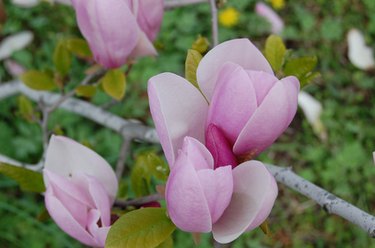
Magnolias and camellias are eye-catching plants with dark green, almost leathery leaves and large, showy blooms. Magnolias, a symbol of the South, may actually be grown successfully from Florida to Maine in the Eastern United States and can be evergreen or deciduous. The trees produce large, saucer- or start-shaped white, pink, red or purple blooms in spring. Camellias bloom from winter to spring in the South and grow most successfully in Florida, Georgia and the Carolinas. They may also be successfully grown in colder climates with winter protection. Proper fertilization is essential for best flower production.
Benefits
Video of the Day
Along with watering and pruning, fertilizer is a vital component of an effective maintenance program for both camellias and magnolias. Fertilizer adds nutrients to the soil that help the plants produce thicker, stronger foliage and branches, and to produce the highest quality blooms. Strong, healthy shrubs are also better able to resist damaging diseases.
Video of the Day
Fertilizer Types
Both granular and liquid fertilizers are readily available at commercial nurseries and stores with gardening sections. Fertilizer may instantly impart its nutrients to the soil, or may be slow- or controlled-release, allowing the plants to absorb nutrients gradually. Camellias and magnolias benefit most from slow-release fertilizers so the nitrogen in the fertilizer is available to the plant longer. You can use azalea food on camellias and magnolias. Have your soil tested to determine what nutrients your trees need and in what amounts.
Fertilizing Magnolias
Magnolias are susceptible to canker diseases that can kill the branches. Proper fertilizing helps prevent canker from infecting the trees. Use a balanced fertilizer formulated for acid-loving plants and follow package directions. Fertilize magnolias annually in early spring, when new growth first begins to appear. Wait until the spring following the date you plant the magnolia to begin fertilizing, unless a soil test indicates the need to feed the plant immediately. With careful pruning and care, dwarf magnolias may be grown in containers outdoors. Follow the same feeding program as with garden-grown magnolias.
Fertilizing Camellias
Apply camellia or azalea food beginning in spring, following manufacturer's directions. Fertilize outdoor camellias with a complete granular fertilizer before new growth appears, after the first spurt of new growth, midsummer and early winter once the plant becomes dormant. Follow package directions and water the plants thoroughly after applying the fertilizer. Feed container-grown dwarf camellias every two months with a balanced, slow-release fertilizer. If the potted camellia begins to appear spindly or leggy, reduce the amount of fertilizer you use.